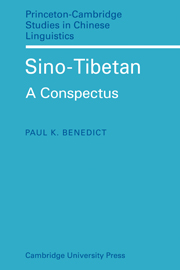Book contents
- Frontmatter
- Foreword
- Contents
- Preface
- Abbreviations
- 1 Introduction
- 2 Taxonomy (general)
- 3 Taxonomy (Sino-Tibetan)
- 4 Tibeto-Burman classification
- 5 Tibeto-Burman reconstruction (history)
- 6 Tibeto-Burman primary sources
- 7 Tibeto-Burman consonants (general; final)
- 8 Tibeto-Burman consonants (initial)
- 9 Tibeto-Burman consonant clusters
- 10 Tibeto-Burman vowels (finals; diphthongs)
- 11 Tibeto-Burman vowels (medials)
- 12 Tibeto-Burman tones
- 13 Tibeto-Burman morphology (history)
- 14 Tibeto-Burman morphology (categories)
- 15 Tibeto-Burman pronouns
- 16 Tibeto-Burman numerals
- 17 Tibeto-Burman morphology and syntax (general)
- 18 Tibeto-Burman affixes (special)
- 19 Tibeto-Burman affixes (general)
- 20 Tibeto-Burman dental suffixes
- 21 Tibeto-Burman prefixes (general)
- 22 Tibeto-Burman prefixed *s-
- 23 Tibeto-Burman prefixed *r-
- 24 Tibeto-Burman prefixed *b-
- 25 Tibeto-Burman prefixed *g-
- 26 Tibeto-Burman prefixed *d-
- 27 Tibeto-Burman prefixed *m-
- 28 Tibeto-Burman prefixed *a-
- 29 Tibeto-Burman alternation (consonantal, vocalic)
- 30 Karen (general)
- 31 Karen morphology (categories) and syntax
- 32 Karen pronouns
- 33 Karen numerals
- 34 Karen prefixes
- 35 Karen initial consonants and clusters
- 36 Karen final consonants and medial vowels
- 37 Karen final vowels and semi-vowels
- 38 Karen tones
- 39 Chinese (general, history)
- 40 Chinese morphology (prefixes, suffixes, alternation)
- 41 Chinese pronouns
- 42 Chinese numerals
- 43 Chinese phonology (history)
- 44 Chinese consonants (initials, finals)
- 45 Chinese consonant clusters
- 46 Chinese vowels and diphthongs
- 47 Chinese tones
- 48 Résumé (Chinese)
- Appendix I Tibeto-Burman roots
- Appendix II English–TB index
- Appendix III Primary Tibeto-Burman sources
- Appendix IV Author's and editor's bibliography
47 - Chinese tones
Published online by Cambridge University Press: 10 November 2010
- Frontmatter
- Foreword
- Contents
- Preface
- Abbreviations
- 1 Introduction
- 2 Taxonomy (general)
- 3 Taxonomy (Sino-Tibetan)
- 4 Tibeto-Burman classification
- 5 Tibeto-Burman reconstruction (history)
- 6 Tibeto-Burman primary sources
- 7 Tibeto-Burman consonants (general; final)
- 8 Tibeto-Burman consonants (initial)
- 9 Tibeto-Burman consonant clusters
- 10 Tibeto-Burman vowels (finals; diphthongs)
- 11 Tibeto-Burman vowels (medials)
- 12 Tibeto-Burman tones
- 13 Tibeto-Burman morphology (history)
- 14 Tibeto-Burman morphology (categories)
- 15 Tibeto-Burman pronouns
- 16 Tibeto-Burman numerals
- 17 Tibeto-Burman morphology and syntax (general)
- 18 Tibeto-Burman affixes (special)
- 19 Tibeto-Burman affixes (general)
- 20 Tibeto-Burman dental suffixes
- 21 Tibeto-Burman prefixes (general)
- 22 Tibeto-Burman prefixed *s-
- 23 Tibeto-Burman prefixed *r-
- 24 Tibeto-Burman prefixed *b-
- 25 Tibeto-Burman prefixed *g-
- 26 Tibeto-Burman prefixed *d-
- 27 Tibeto-Burman prefixed *m-
- 28 Tibeto-Burman prefixed *a-
- 29 Tibeto-Burman alternation (consonantal, vocalic)
- 30 Karen (general)
- 31 Karen morphology (categories) and syntax
- 32 Karen pronouns
- 33 Karen numerals
- 34 Karen prefixes
- 35 Karen initial consonants and clusters
- 36 Karen final consonants and medial vowels
- 37 Karen final vowels and semi-vowels
- 38 Karen tones
- 39 Chinese (general, history)
- 40 Chinese morphology (prefixes, suffixes, alternation)
- 41 Chinese pronouns
- 42 Chinese numerals
- 43 Chinese phonology (history)
- 44 Chinese consonants (initials, finals)
- 45 Chinese consonant clusters
- 46 Chinese vowels and diphthongs
- 47 Chinese tones
- 48 Résumé (Chinese)
- Appendix I Tibeto-Burman roots
- Appendix II English–TB index
- Appendix III Primary Tibeto-Burman sources
- Appendix IV Author's and editor's bibliography
Summary
The Chinese tonal system can be interpreted in terms of three tonemes, viz. level (unmarked), rising, and falling, or pʿing shêng, shang shêng, and chʿü shêng, respectively. The so-called ju shêng of Chinese philologists is simply the level tone in syllables with final stop consonant (glottal stop in many modern dialects). The three tonemes are conditioned (in Ar. and Anc. Ch.) by the initial, being relatively high in words with surd initial, relatively low in words with sonant initial. With the general shift from sonant to surd initials shortly after the Anc. Ch. period (A.D. 600–900), the high and low varieties of each toneme tended to become phonemically distinct, so that all modern dialects have several separate tonemes. The falling toneme has generally been regarded as of late origin, by Chinese as well as Western scholars. It is undoubtedly significant that many Anc. Ch. words derived from Ar. Ch. forms in -g or -d should bear this toneme, but we find it also with words in final -m, -n, or -ng, in which loss of final cannot be postulated. We must infer, then, that all three tonemes existed in Ar. Ch.
A careful comparison of Chinese tones with the Tibeto-Karen system represented by Burmese-Lolo and Karen has yielded no positive results.
- Type
- Chapter
- Information
- Sino-TibetanA Conspectus, pp. 193 - 194Publisher: Cambridge University PressPrint publication year: 1972



